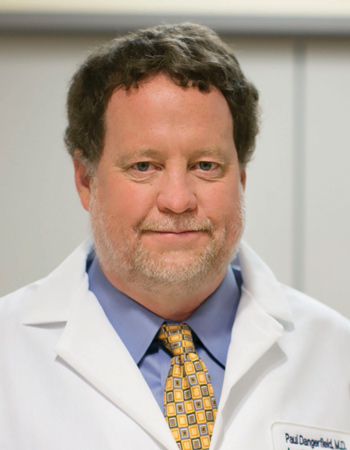Managing pain associated with a serious trauma or surgery is a critical part of treatment – especially at GW Hospital, where more than 2,000 patients each year go to the Level 1* trauma center for lifesaving care.
 For well over a decade, the hospital’s acute pain management team has been utilizing an innovative approach that can support better outcomes and lessen the risk of negative side effects, including but not limited to opioid addiction. “We’re in an area where there are a lot of opioid-related deaths and a lot of addictions across all socioeconomic lines,” says Paul Dangerfield, MD, Director of Acute Pain Management Service. “This is a huge society issue.”
For well over a decade, the hospital’s acute pain management team has been utilizing an innovative approach that can support better outcomes and lessen the risk of negative side effects, including but not limited to opioid addiction. “We’re in an area where there are a lot of opioid-related deaths and a lot of addictions across all socioeconomic lines,” says Paul Dangerfield, MD, Director of Acute Pain Management Service. “This is a huge society issue.”
More Medications, Smaller Doses
Dr. Dangerfield explains that a focus of GW Hospital’s pain management program is to use narcotics in a controlled way as just one part of a multimodal approach. Based on patients’ individual needs, they are given multiple medications that work on different receptors in smaller doses. “Almost all negative reactions are dose-related,” Dr. Dangerfield says. Lowering the dose reduces the chance of having unwanted side effects like chemical addiction. Not only is this approach safer, but it also can be more effective in managing pain. A key component of the pain program was adapted from the military and involves using nerve blocks to continually administer numbing medication to nerves that provide sensation to the affected part of the body where the pain is located. With this approach, medication is delivered through catheters attached to small portable pumps, which patients wear in the first crucial days of their recovery.
 In many cases, patients may go home with these nerve blocks, and because their pain is better controlled, they can better take care of themselves, which advances their recovery without prolonged use of opioids. “This early and aggressive pain management makes an enormous difference,” says Dr. Dangerfield. Anesthesiologist Marian Sherman, MD, who works with Dr. Dangerfield in the pain program, notes that the hospital’s protocols can also reduce the risk of long-term problems. “If they have excellent pain control in that acute period, the first 24 to 72 hours, patients are less likely to develop chronic pain,” she says.
In many cases, patients may go home with these nerve blocks, and because their pain is better controlled, they can better take care of themselves, which advances their recovery without prolonged use of opioids. “This early and aggressive pain management makes an enormous difference,” says Dr. Dangerfield. Anesthesiologist Marian Sherman, MD, who works with Dr. Dangerfield in the pain program, notes that the hospital’s protocols can also reduce the risk of long-term problems. “If they have excellent pain control in that acute period, the first 24 to 72 hours, patients are less likely to develop chronic pain,” she says.
Did you know ...
- Every day, more than 130 people in the United States die after overdosing on opioids.*
- In 2017, there were 244 overdose deaths involving opioids in Washington, DC – a rate of 34.7 deaths per 100,000 persons, which is over twice the national rate and the 3rd highest rate in the country.*
*Source: National Institute on Drug Abuse
It Takes a Team
In addition to inpatient care, GW Hospital also offers advanced pain management and nerve blocks for certain outpatient surgeries. When patients go home, they are given a phone number they can call any time, 24/7, for personal support from a member of the pain management team.
“It takes a lot of people to do this, it’s a very resource-intensive treatment plan,” says Dr. Dangerfield. To address the need for more government support and resources in this area, he has visited Capitol Hill with Dr. Sherman and pro bono lobbyists (see next page) to help educate lawmakers about the training, funding, insurance compensation and other support needed to make this level of care more widely available. Until insurance reimbursement is provided to cover the cost of treating acute pain and get a system like GW Hospital’s up and running, most places are going to say, “It’s too expensive, too resource-intensive,” Dr. Dangerfield says.
“We’re lucky that Kim Russo (the hospital CEO) is here. Kim had the vision. She took the risk, and it’s paid off, because I think we’re very far ahead of the curve ... When you make someone’s pain better, it is gratifying to the core.”
*GW Hospital is an American College of Surgeons-verified Level 1 trauma center

